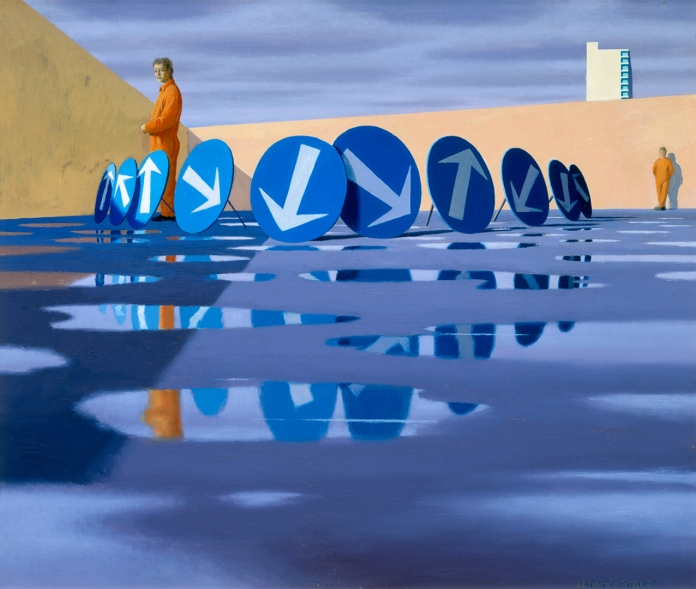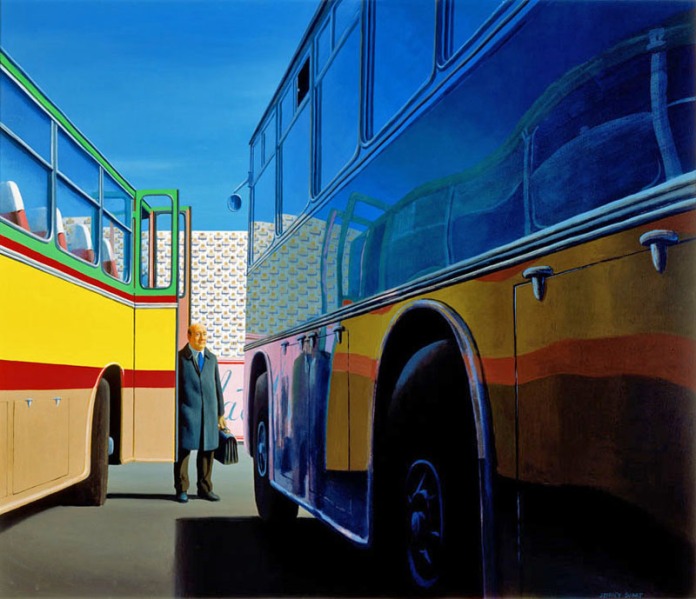Kweiseye is an art criticism blog written by Tom Kwei. If you enjoy this article, browse the archive HERE for more than 60 other critiques of both artists and exhibitions. Any questions/queries/use: tomkweipoet@gmail.com
Despite being one of Australia’s most acclaimed and accomplished painters, Jeffrey Smart’s recognition here in England is as enigmatic as his work. Which is a shame really as through their stark and striking portrayals of the everyday, his paintings intrigue in the way that they attain a certain absurd quality in spite of always showcasing familiar & believable realities. There are no half-fish women here then, rather the emphasis is on order and shape, with the painter once poignantly declaring that: “The subject matter is only the hinge that opens the door, the hook on which hangs a coat. My only concern is putting the right shapes in the right colours in the right places. It is always the geometry”
‘Reflected Arrows’ – 1974
At the centre of this image a cluster of recognisable arrow symbols collect. Whilst normally alone on a roadside they hold little significance, now bundled together in a shape that seems itself an arrow of sorts pointed at the viewer, they obtain a strange coherence and power. The three on the left especially all seem to point up to a uniformed worker, one whose gaze follows the suggestion of the blue circles towards us in reserved disinterest. At the far right a more relaxed figure can be seen, his face barely visible against the fleshy pallor of the long back wall.
It is the way the signs behave with the water rather than before us however that is the most interesting part of the painting. In spite of nothing beyond the usual being displayed – just mere directional signs above puddles – the level of fragmentation and abstraction suggests a surrealist element to this anonymous building site corner. From the various waters come new angles and reflections that are jagged and cut in the shallow sections. Some arrows point down and meet themselves in infinite reflection, others suggest new directions and distance.
Just as the signifiers obtain symmetry or disjunction through the floor, Smart coyly suggests equanimity between the long orange slick of the worker’s reflection through the water and the single high-rise building cutting above the top right of the image. We are reminded then in both cases of a world tantalisingly outside all of this. These signs eventually after all, have to go somewhere, serving some direction beyond the canvas.
‘The Traveller’ – 1973
I love the funnelling of our perspective in this piece, the way that Smart draws us squinting down between the two coaches to the eponymous ‘Traveller’ at their parked centre. The severity of color here is also wonderful, with the crisp yellows and reds of the left vehicle dragging our gaze further inward until the open door curves towards the mysterious passenger standing aloof.
Through the masterful reflection work between the left coach into the right, Smart evokes a wonderful netherworld of instability. With the aforementioned crisp reds becoming muttered & muted, the traveller’s face too is distorted by the holding bay clasps. It isn’t only the right vehicle that twists its surroundings however, in the high windows of the left coach too the seemingly cupcake background behind the man is echoed onward in the mirrored windows.
We can assume perhaps that the man is a rep of sorts, a mover that never stays still, which lends the deathly ambience of the scene an altogether more developed sense of quiet. He seems of another world really, and if it wasn’t for the subtle open window on the high edge of the left coach, it would seem that he was the only one there.
Enjoy reading that? Click HERE to see a list of all the art analyses on Kweiseye to date.
To keep up with the blog and all the art I write about, follow me right here on this blog or here @tomkweipoet


